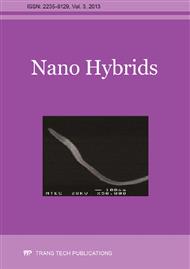[1]
Z. Luo, A. Soria, Introduction, Prospective Study of The World Aluminium Industry, European Commission, Institute for Prospective Technologies Studies, (2008), 1-2.
Google Scholar
[2]
R.D. Peterson, Lee Newton Review of Aluminium Dross Processing, Light Metals, 2002, Wolfgang Schneider (Ed. ), Minerals, Metals & Materials Society, North Carolina, (2002).
Google Scholar
[3]
J. Mukhopadhyay, Y.V. Ramana, U. Singh, Extraction of Value Added Products from Aluminium Dross Material to Achieve Zero Waste, Light Metals, 2004, A.T. Tabereaux (Ed. ), Minerals, Metals & Materials Society, North Carolina, (2004).
Google Scholar
[4]
J. Aquilar-Santillan, H. Balmori-Ramirez, R.C. Bradt, Sol-gel formation and kinetic analysis of the in-situ/selfseeding transformation of bayerite to α- alumina, J. Ceram. Process. Res. 5(3) (2004) 196-202.
Google Scholar
[5]
G.R. Kargedov, N.Z. Lyakhov, Mechanochemical grinding of inorganic oxides, Kona, 21 (2003) 76-87.
DOI: 10.14356/kona.2003011
Google Scholar
[6]
R. Tomasi, A.A. Rabelo, A.S.A. Chinelatto, L. Reis and W.J. Botta F, Characterization of high energy milled alumina powders, Ceramica 44 (289) (1998) 1-11.
DOI: 10.1590/s0366-69131998000500003
Google Scholar
[7]
C.C. Yong and J. Wang, Mechanical-activation-triggered gibbsite-to-boehmite transition and activation-derived alumina opowders, J. Am. Ceram. Soc. 84 (2001) 1-11.
DOI: 10.1111/j.1151-2916.2001.tb00820.x
Google Scholar
[8]
J. Temuujin, T. Jadambaa, K.J.D. Mackenzie, P. Angerer, F. Porte, F. Riley, Thermal formation of corundum from aluminium hydroxides prepared from various aluminium salts, Bull. Mater. Sci. 23 (4) (2000) 301-304.
DOI: 10.1007/bf02720086
Google Scholar
[9]
J. Kano, S. Saeki, F. Saito, M. Tanjo, S. Yamazaki, Application of dry grinding to reduction in the transformation temperature of alumina hydroxides, Int. J. Miner. Process, 60 (2000) 91-100.
DOI: 10.1016/s0301-7516(00)00005-3
Google Scholar


